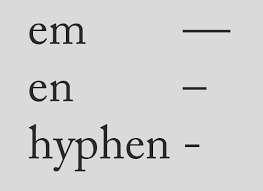It’s clear that these three dash types don’t get the respect they deserve—as indicated by the fact that many of you are wondering what the heck I’m talking about.
Yes, it’s true. Three different dashes, each with distinct uses:
– Short (the hyphen or dash)
– Medium (the en dash)
— Long (the em dash)
Getting these dashes right is important, even though it seems a minor punctuation detail not worth bothering over (and most writers don’t). Proper use of the em dash, en dash, and hyphen distinguishes you as a competent writer and expands your expressive options. Unfortunately, many business people have little time to parse such detail, and frequently, in fact more often than not, don’t bother.
So, how is each of these distinct dash types used?
Em Dash
Em dashes are used to separate phrases—as you would use commas, parentheses, semicolons, colons, ellipses—and isolate ancillary thoughts, offset examples, signal an interruption, or indicate emphasis. It separates distinct parts of a sentence by adding a discernable pause that’s stronger than a comma, but not as abrupt as a colon, semicolon or pair of parentheses.
It’s quite a versatile punctuation mark, but shouldn’t be used more than twice in a single sentence. Writers shouldn’t overuse the em dash either; it becomes a distraction. So, use it judiciously.
When a pair of em dashes is used in place of commas they enhance readability and accentuate the offset phrase.
When a pair of em dashes is used in place of parentheses they draw more attention to the parenthetical content, so don’t use them if you don’t want the content to stand out. Parentheses work better for content you want to present more subtly.
When used in place of a colon, a single em dash emphasizes (offsets) a final point, note or conclusion in a less formal way—like this.
En Dash
The en dash (–) is a bit wider than the hyphen (-) and narrower than the em dash (—). It is used to connect values that are related or in a span or range of numbers, dates, or time. It’s commonly used to symbolize the word “to” or “through” between values:
- The Bearcats won 12–3.
- World War I spanned 1914–1918.
- Pages 152–180 contain the most important parts.
- The cafeteria is open 7:00 a.m.–3:00 p.m.
- Exhibits B–G.
But, don’t use the en dash if the span or range is introduced with words such as from or between.
- Right: General MacArthur was Field Marshall of the Philippine Army from 1935 to 1937.
- Wrong: General MacArthur was Field Marshall of the Philippine Army from 1935–1937.
- Right: The happiest years of the partnership were undoubtedly between 2010 and 2013.
- Wrong: The happiest years of the partnership were undoubtedly between 2010–2013.
The en dash is also used when referencing scores and contest results:
- The members rejected the initiative by a 75–21 vote.
- The Monsters beat the Aliens 10–3 in overtime.
Finally, use the en dash between words that present a conflict, connection, contrast, or direction:
- The evolution–creationism debate.
- The Detroit–Memphis route.
- Montana–Idaho exchange protocol.
- Running east–west between Palm and Fifth is a track for public use.
- Sarbanes–Oxley Act (and other works by joint authors).
Hyphen
Hyphens are used to join compound words, separate syllables, break words from one line to the next, or hyphenate names.
- anti-slavery
- hard-boiled eggs
- em-dash
- it’s pronounced: Mis-si-si-ppee
- Wal-Mart
- Daniel Day-Lewis
Does using the right dash form for its intended applications really matter? Yes.
Why? First, many of your readers will notice your mistakes. Second, it’s a real distraction to see otherwise good business prose encumbered by a sprinkling of incorrect dash types. When I see this I wonder if schools even teach grammar and punctuation any more. After all, it’s not like this is rocket science. Third, proper use of these distinct marks allows you to improve the clarity and flow of your writing. Fourth, improper use can confuse the reader, send the wrong cues, interrupt your meaning and slow the reader down.
Finding the em dash and en dash
While word processors usually automatically insert an em dash when you type two hyphens, keyboards typically lack dedicated keys for the em or en dash. Word processors provide for insertion of these marks—you just have to you know where to find them (or the shortcut key combination). A good place to look is on the “insert” “symbol” menu. In Microsoft Word, the en dash and em dash are available on the insert symbols menu (alt+I, S, then see the “special characters” tab (alt p)).
To use the correct dash or hyphen in HTML use the following:
|
–
|
Hyphen
|
– (on keyboard)
|
|
–
|
En dash
|
– or –
|
|
—
|
Em dash
|
— or —
|
|
Minus sign
|
−
|
Spaces with the Em dash and the En dash
The em dash is typically used without spaces on either side, but many newspapers—which follow AP style—insert a single space both before and after the em dash.
The en dash can appear with or without spaces on either side, depending on the application. Usually, it should be used without spaces.
